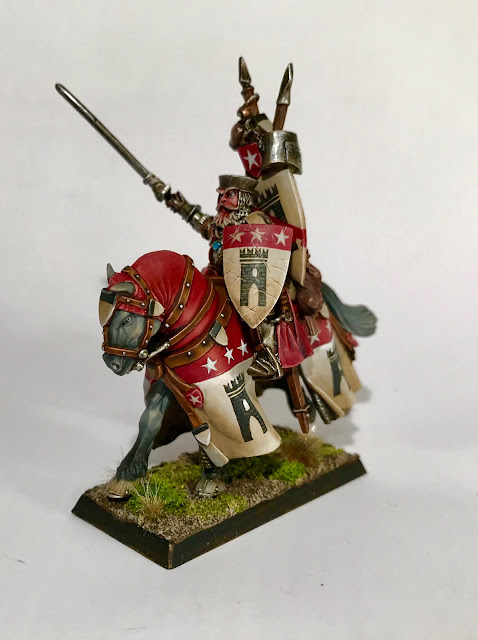After receiving numerous requests to share with you my marble recipe I finally decided to write a short tutorial with some picture of how the process is done... It is actually really easy and straightforward so it won't be a long post but hopefully you will find it useful. If you have any comment or question just write a comment and I will do my best to respond.
Ok, let's start!
Stage 1: Basecoat and first shading
After cleaning and assembling the model I gave it a basecoat of Corax White spray, which I subsequently retouched by brush with Ceramite White. Once this base was completely dry I applied the first shade. For this I chose a mix of 50/50 Reikland Fleshshade and Lahmian Medium and generously applied it to the whole model. As you probably know the medium prevents the shade to form stains while it dries creating a more even and smoother finish.
Stage 2: Second shading
Once the Reikland Fleshshade has dried out completely (some 30 mins) I applied a second shade with Drakenhof Nightshade, in the same way as the first wash, diluted with Lahmian medium, this time though the ratio was 25% shade 75% medium (Drakenhof is a very dark and strong shade and you just want it to be very subtle, not make your marble too blue). Wait for this coat to dry and then apply a little bit of extra Drakenhof shade (again 25/75 with LM) to some random areas of the model. This is done to mimic the fact that marble has pretty random and dishomogeneus stains so don't worry too much about some of it drying and leaving a slight stain over some areas, you will be able to make it look like marble natural imperfections later on.
Stage 3: highlights and touching ups
Nothing special here, just go back with a thin brush over the edges of the armour with a standard edge highlight with pure white (I used Ceramite White).
Stage 4: Pencil marks
Ok, here goes the fun part. With a tiny mechanical pencil (I used a BIC with an HB point) draw very carefully some random lines along the armour. Do not apply too much pressure and try not to exaggerate with the amount of lines you draw. These represents marble veins and will go a really long way simulating the right effect. Take your time with this stage, I find it quite enjoyable as it is one of those rare special effects techniques that really change dramatically the look of the miniature in a few stokes.
It's done! To be honest you can easily skip this passage and stick to stage 4 but I prefer to push it the extra mile and retouch the veins I just drew with fine lines of Reikland Fleshshade and drakenhof Nightshade. Just use a fine brush and take some colour straight form the pot and apply it trying to follow roughly the pencil marks. It's not necessary to be too precise, marble veins are irregular in nature and you can achieve a great result even with a shaky hand.
There you go! It's truly a quick and easy technique which gives great results! It is also great if you want to batch paint a whole army as it mainly consists of shades over a white base coat.
If any of you guys wants to give it a go and share the results please do not be shy and email me, I'd love to look at your models!
Hagen












